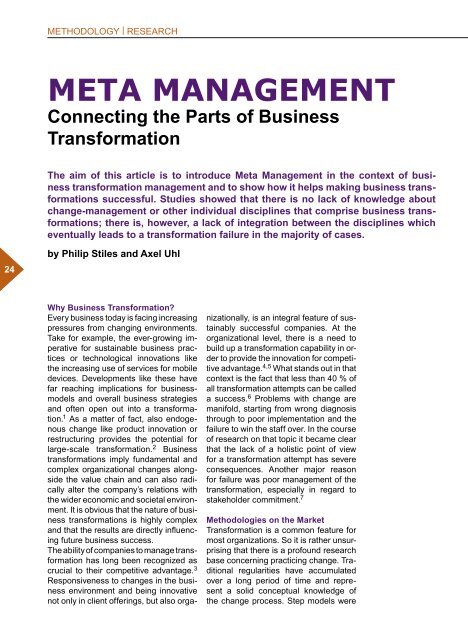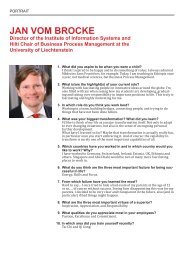META MANAGEMENT Connecting the Parts of Business - BTA online
META MANAGEMENT Connecting the Parts of Business - BTA online
META MANAGEMENT Connecting the Parts of Business - BTA online
You also want an ePaper? Increase the reach of your titles
YUMPU automatically turns print PDFs into web optimized ePapers that Google loves.
24<br />
METHODOLOGY | RESEARCH<br />
<strong>META</strong> <strong>MANAGEMENT</strong><br />
<strong>Connecting</strong> <strong>the</strong> <strong>Parts</strong> <strong>of</strong> <strong>Business</strong><br />
Transformation<br />
The aim <strong>of</strong> this article is to introduce Meta Management in <strong>the</strong> context <strong>of</strong> business<br />
transformation management and to show how it helps making business transformations<br />
successful. Studies showed that <strong>the</strong>re is no lack <strong>of</strong> knowledge about<br />
change-management or o<strong>the</strong>r individual disciplines that comprise business transformations;<br />
<strong>the</strong>re is, however, a lack <strong>of</strong> integration between <strong>the</strong> disciplines which<br />
eventually leads to a transformation failure in <strong>the</strong> majority <strong>of</strong> cases.<br />
by Philip Stiles and Axel Uhl<br />
Why <strong>Business</strong> Transformation?<br />
Every business today is facing increasing<br />
pressures from changing environments.<br />
Take for example, <strong>the</strong> ever-growing imperative<br />
for sustainable business practices<br />
or technological innovations like<br />
<strong>the</strong> increasing use <strong>of</strong> services for mobile<br />
devices. Developments like <strong>the</strong>se have<br />
far reaching implications for businessmodels<br />
and overall business strategies<br />
and <strong>of</strong>ten open out into a transformation.<br />
1 As a matter <strong>of</strong> fact, also endogenous<br />
change like product innovation or<br />
restructuring provides <strong>the</strong> potential for<br />
large-scale transformation. 2 <strong>Business</strong><br />
transformations imply fundamental and<br />
complex organizational changes alongside<br />
<strong>the</strong> value chain and can also radically<br />
alter <strong>the</strong> company’s relations with<br />
<strong>the</strong> wider economic and societal environment.<br />
It is obvious that <strong>the</strong> nature <strong>of</strong> business<br />
transformations is highly complex<br />
and that <strong>the</strong> results are directly influencing<br />
future business success.<br />
The ability <strong>of</strong> companies to manage transformation<br />
has long been recognized as<br />
crucial to <strong>the</strong>ir competitive advantage. 3<br />
Responsiveness to changes in <strong>the</strong> business<br />
environment and being innovative<br />
not only in client <strong>of</strong>ferings, but also orga-<br />
nizationally, is an integral feature <strong>of</strong> sustainably<br />
successful companies. At <strong>the</strong><br />
organizational level, <strong>the</strong>re is a need to<br />
build up a transformation capability in order<br />
to provide <strong>the</strong> innovation for competitive<br />
advantage. 4,5 What stands out in that<br />
context is <strong>the</strong> fact that less than 40 % <strong>of</strong><br />
all transformation attempts can be called<br />
a success. 6 Problems with change are<br />
manifold, starting from wrong diagnosis<br />
through to poor implementation and <strong>the</strong><br />
failure to win <strong>the</strong> staff over. In <strong>the</strong> course<br />
<strong>of</strong> research on that topic it became clear<br />
that <strong>the</strong> lack <strong>of</strong> a holistic point <strong>of</strong> view<br />
for a transformation attempt has severe<br />
consequences. Ano<strong>the</strong>r major reason<br />
for failure was poor management <strong>of</strong> <strong>the</strong><br />
transformation, especially in regard to<br />
stakeholder commitment. 7<br />
Methodologies on <strong>the</strong> Market<br />
Transformation is a common feature for<br />
most organizations. So it is ra<strong>the</strong>r unsurprising<br />
that <strong>the</strong>re is a pr<strong>of</strong>ound research<br />
base concerning practicing change. Traditional<br />
regularities have accumulated<br />
over a long period <strong>of</strong> time and represent<br />
a solid conceptual knowledge <strong>of</strong><br />
<strong>the</strong> change process. Step models were
Abstract<br />
<strong>the</strong> first to emerge with a classic formulation<br />
<strong>of</strong> three phases: current state, future<br />
state, and transition state. 8 Gap and<br />
force field analysis usually accompanied<br />
<strong>the</strong> models. 9 Inherent in <strong>the</strong> step models<br />
is a combination <strong>of</strong> both rational elements<br />
– for example diagnosing need,<br />
shaping <strong>the</strong> vision, and monitoring progress<br />
– and emotional elements, that is,<br />
mobilizing commitment, engaging with<br />
<strong>the</strong> vision, and building affinity and identity<br />
with <strong>the</strong> change. The models have<br />
produced a variety <strong>of</strong> patterns for managing<br />
change, concerning leadership,<br />
culture, and maintaining momentum.<br />
However, <strong>the</strong>re are a number <strong>of</strong> issues<br />
raised by <strong>the</strong> use <strong>of</strong> step models. Firstly,<br />
<strong>the</strong>y imply a linear approach to changemanagement,<br />
with each step leading<br />
to <strong>the</strong> next. Though feedback loops<br />
are nearly always included, essentially<br />
<strong>the</strong>se models are mechanistic in <strong>the</strong>ir approach.<br />
Secondly, <strong>the</strong> links between <strong>the</strong><br />
steps are rarely described. So despite<br />
<strong>the</strong> fact that each individual element in<br />
<strong>the</strong> model is outlined, <strong>the</strong> overall change<br />
process remains incomprehensible.<br />
This is problematic, both <strong>the</strong>oretically<br />
and practically. In <strong>the</strong>oretical terms it is<br />
unclear how change is managed, as a<br />
collection <strong>of</strong> routines is missing a crucial<br />
linking part. Calls to approach change<br />
from a more holistic point <strong>of</strong> view have<br />
not been included in <strong>the</strong> tradition <strong>of</strong> step<br />
models. In practical terms, how transformation<br />
is enacted not just in a piecemeal<br />
way but in a synchronized manner is not<br />
answered.<br />
METHODOLOGY | RESEARCH<br />
Until now a number <strong>of</strong> approaches<br />
sought to implement a holistic view and<br />
to fill <strong>the</strong> afore mentioned gap. The “7s<br />
framework” by McKinsey, <strong>the</strong> “Balanced<br />
Scorecard” by Kaplan and Norton, and<br />
“Lean” or “Six Sigma” are <strong>the</strong> most commonly<br />
known ones.<br />
The “7s framework” revolves around seven<br />
core elements <strong>of</strong> an organization and<br />
argues for <strong>the</strong>ir mutual linkage should<br />
<strong>the</strong> organization be affected by change<br />
drivers. 10 However, this tool is more a<br />
diagnostic than an implementation technique,<br />
and while useful in analytic terms,<br />
it does not reveal specific aspects <strong>of</strong> <strong>the</strong><br />
change elements or <strong>the</strong>ir linkages.<br />
The balanced scorecard approach identifies<br />
a number <strong>of</strong> core areas, such as financial,<br />
customer, process, and people. 11<br />
This approach shows <strong>the</strong> inter-linkages<br />
between <strong>the</strong> various areas and is helpful<br />
in providing guidance to an overall integration,<br />
but it does not present a methodology<br />
for <strong>the</strong> process <strong>of</strong> transforming<br />
organizations.<br />
Lean, or Six Sigma, approaches try to<br />
shed some light on change through<br />
“business excellence” models. They provide<br />
a number <strong>of</strong> standard tools, primarily<br />
focusing on project management and<br />
statistical control to manage change. 12<br />
The emphasis lies clearly on <strong>the</strong> rational<br />
side <strong>of</strong> change, with <strong>the</strong> emotional<br />
aspects rarely addressed. Given that a<br />
large part <strong>of</strong> change success rests on<br />
<strong>the</strong> appropriate management <strong>of</strong> people,<br />
more is needed to have a solid and effective<br />
change process.<br />
In response to <strong>the</strong> limitations <strong>of</strong> existing methods and management approaches and in view <strong>of</strong> <strong>the</strong><br />
complexity <strong>of</strong> business transformation, successful business transformation management can be seen<br />
as a Meta Management discipline that integrates and extends individual management disciplines. In<br />
<strong>the</strong> course <strong>of</strong> <strong>the</strong> article, an overview <strong>of</strong> <strong>the</strong> current state <strong>of</strong> research is given and hence <strong>the</strong> causes for<br />
creating a holistic approach. Then, Meta Management is briefly described and put into <strong>the</strong> context <strong>of</strong><br />
business transformation management. It is explained why Meta Management augments <strong>the</strong> likelihood<br />
<strong>of</strong> a successful transformation. The authors emphasize that Meta Management may not be seen as<br />
a cookery book for any intricacy during a transformation, but is well meant to provide a framework for<br />
coherent, consistent, and successful business transformation management.<br />
25
26<br />
METHODOLOGY | RESEARCH<br />
The Missing Link<br />
Contrary to <strong>the</strong> welter <strong>of</strong> books, cases,<br />
and how-to manuals on managing<br />
change, <strong>the</strong> integration <strong>of</strong> key concepts<br />
and <strong>the</strong>ir execution within transformation<br />
has been elusive so far. The nature<br />
<strong>of</strong> transformation is to range across an<br />
organization, which implies that transformation<br />
will come about when different<br />
disciplines come toge<strong>the</strong>r and cohere<br />
behind a common direction. 13 With <strong>the</strong><br />
inauguration <strong>of</strong> <strong>the</strong> <strong>Business</strong> Transformation<br />
Academy and <strong>the</strong> inherent Thought<br />
Leadership Network in 2009, one <strong>of</strong> <strong>the</strong><br />
first aims was to create holistic knowledge<br />
about business transformation and to provide<br />
<strong>the</strong> right means for orchestrating <strong>the</strong><br />
individual parts <strong>of</strong> business transformation<br />
management. The first milestone <strong>of</strong><br />
<strong>the</strong> network was to create <strong>the</strong> <strong>Business</strong><br />
Transformation Management Methodology<br />
(BTM 2 ), a comprehensive and holistic<br />
methodology for managing business<br />
transformation. <strong>Business</strong> transformation<br />
itself has been defined as a top-down<br />
phenomenon, starting at <strong>the</strong> C-level.<br />
Some o<strong>the</strong>r key characteristics are that<br />
business transformation management<br />
needs to be business driven, value-oriented,<br />
and an end-to-end process in order to<br />
be effective. In addition to that, <strong>the</strong>re are<br />
many interdependencies between individual<br />
management disciplines that need to<br />
be orchestrated during a transformation.<br />
BTM 2 incorporates a number <strong>of</strong> key features<br />
from established transformation approaches,<br />
such as stage models and balanced<br />
scorecard approaches. The eight<br />
disciplines are chosen in a logical way<br />
and are <strong>of</strong> two types:<br />
1. Directional. The Strategy, Value, and<br />
Risk Management disciplines create<br />
<strong>the</strong> case for action and vision <strong>of</strong> <strong>the</strong> future<br />
and set <strong>the</strong> direction for <strong>the</strong> transformation<br />
effort.<br />
2. Enablement. The management <strong>of</strong><br />
changes ranging from IT through process<br />
to organizational, plus <strong>the</strong> creation<br />
<strong>of</strong> new competences through training<br />
and education, supervised through an<br />
organizational program management<br />
capability.<br />
Risk<br />
Mgt.<br />
Training<br />
and Skills<br />
Mgt.<br />
Change<br />
Mgt.<br />
Strategy<br />
Mgt.<br />
Meta<br />
Leadership<br />
Mgt.<br />
Program<br />
Mgt.<br />
IT Mgt.<br />
Value<br />
Mgt.<br />
Process<br />
Mgt.<br />
These disciplines are chosen as components<br />
<strong>of</strong> <strong>the</strong> transformation management<br />
methodology because <strong>the</strong>y are directly<br />
connected and form a logical construct:<br />
Every transformation starts with a formulation<br />
<strong>of</strong> a strategy and a vision. Defining<br />
a new business strategy <strong>of</strong>ten becomes<br />
<strong>the</strong> only viable option to react to a<br />
changing environment. Next, a strategy<br />
can only be implemented if certain processes<br />
change. These process changes<br />
build <strong>the</strong> basis <strong>of</strong> additional benefits that<br />
are generated (Value Management),<br />
and frequently require changed behavior<br />
among <strong>the</strong> employees (Change Management)<br />
as well as new competencies<br />
(Training and Skills Management). Each<br />
change, however, also involves a certain<br />
risk (Risk Management) and many process<br />
changes are only possible using IT<br />
(IT Transformation Management). Transformation<br />
projects are also managed<br />
from cost, benefit, and quality perspectives<br />
and require program organization<br />
and evaluation (Program-Management).<br />
In this vein, <strong>the</strong> most important disci-<br />
DIRECTION<br />
ENABLEMENT<br />
Fig. 1: The Meta<br />
Management<br />
framework
Fig. 2: Phase<br />
model for<br />
business<br />
transformation<br />
© 2010 SAP AG. All rights reserved. / Page 1<br />
plines all find <strong>the</strong>ir place in <strong>the</strong> context<br />
<strong>of</strong> business transformation management<br />
and contribute to a holistic perspective<br />
(see figure 1):<br />
Beyond Linear Thinking<br />
The central part <strong>of</strong> BTM 2 is seen in Meta<br />
Management, which is <strong>the</strong> response to<br />
<strong>the</strong> limitations <strong>of</strong> existing methods and<br />
management approaches. In view <strong>of</strong> <strong>the</strong><br />
complexity <strong>of</strong> business transformation,<br />
in essence successful business transformation<br />
management can be seen as<br />
a Meta Management discipline that integrates<br />
and extends individual management<br />
disciplines. At its core Meta Management<br />
builds on a cyclic phase model<br />
as opposed to linear steps. It incorporates<br />
<strong>the</strong> notion by Peter Senge (author<br />
<strong>of</strong> “The 5th discipline”): “Reality is made<br />
<strong>of</strong> circles but we see straight lines”. 14 The<br />
phase model consists <strong>of</strong> four parts (see<br />
fig. 2): “Envision”, “Engage”, “Transform”,<br />
and “Optimize”, which are cascaded<br />
through all o<strong>the</strong>r disciplines and <strong>the</strong>reby<br />
also part <strong>of</strong> <strong>the</strong> orchestration. Not only<br />
does Meta Management link all parts<br />
METHODOLOGY | RESEARCH<br />
<strong>of</strong> business transformation, but it also<br />
greatly emphasizes and deals with interdependencies.<br />
In <strong>the</strong> Envision phase <strong>the</strong> case for<br />
change is examined, more <strong>of</strong>ten than<br />
not leading to a sense <strong>of</strong> urgency, which<br />
opens out into a vision or strategy. The<br />
Engage phase is synonymous with <strong>the</strong><br />
mobilizing <strong>of</strong> commitment in <strong>the</strong> organization<br />
and o<strong>the</strong>r stakeholders. Involvement<br />
and communication are essential<br />
here, as well as <strong>the</strong> establishment <strong>of</strong> discrete<br />
projects to deliver change and drive<br />
momentum. The Transform phase embraces<br />
<strong>the</strong> actual transformation including<br />
<strong>the</strong> change <strong>of</strong> behavior, processes,<br />
technology, culture, values, and so forth.<br />
In <strong>the</strong> Optimize phase <strong>the</strong> transformation<br />
must be embedded and internalized as<br />
<strong>the</strong> new “business as usual”.<br />
Meta Management is meant to give <strong>the</strong><br />
transformation attempt a structure and<br />
establish <strong>the</strong> guidelines for all management<br />
layers, roles, and disciplines. To<br />
achieve that, it utilizes dimensions <strong>of</strong><br />
<strong>the</strong> Balanced Scorecard, in particular for<br />
planning and control measures.<br />
Envision Engage Transform Optimize<br />
Every <strong>Business</strong> Transformation is an iterative process and goes through different stages in recurring cycles.<br />
Create case for change,<br />
sense <strong>of</strong> urgency,<br />
strategy / vision<br />
Internalize,<br />
institutionalize and<br />
optimize transformation;<br />
create stability<br />
Empower people to act on<br />
<strong>the</strong> vision and plan <strong>the</strong><br />
effort<br />
Change behavior,<br />
processes, technology,<br />
culture, values …<br />
27
28<br />
METHODOLOGY | RESEARCH<br />
Ano<strong>the</strong>r crucial part <strong>of</strong> Meta Management<br />
is <strong>the</strong> focus on <strong>the</strong> people side.<br />
Meta Management includes recommendations<br />
for choosing <strong>the</strong> right leaders<br />
and promoters for key positions. Leadership,<br />
communication, and culture must<br />
not be underestimated, especially during<br />
a transformation. Above that, managing<br />
change under conditions <strong>of</strong> complexity<br />
also implies that change is not just within<br />
<strong>the</strong> organization itself but also through<br />
its relationships with key stakeholders,<br />
such as customers, competitors, government<br />
and regulators, and investors.<br />
Meta Management, in o<strong>the</strong>r words, is enacted<br />
within an ecosystem, and in order<br />
to effect change successfully, <strong>the</strong> metaroutine<br />
is necessary.<br />
In summary, Meta Management provides<br />
<strong>the</strong> following:<br />
– It provides an iterative, cyclic phase<br />
model (Envision, Engage, Transform,<br />
and Optimize).<br />
– It <strong>of</strong>fers an overall business transformation<br />
structure, including management<br />
layers, roles and disciplines.<br />
– It focuses on <strong>the</strong> dimensions <strong>of</strong> <strong>the</strong><br />
Balanced Scorecard for planning<br />
and control measures.<br />
– It delivers decision criteria for choosing<br />
<strong>the</strong> right leaders and promoters<br />
for key positions and facilitates transformation<br />
leadership.<br />
– It creates culture and values on <strong>the</strong><br />
basis <strong>of</strong> transformation principles<br />
and guidelines to internalize and<br />
institutionalize <strong>the</strong> transformation<br />
goals.<br />
– It provides communication and engagement<br />
principles.<br />
Despite <strong>the</strong> direction and coordination<br />
that Meta Management delivers, it may<br />
not be seen as a kind <strong>of</strong> cookery book<br />
that helps prepare an exact transformation<br />
for each specific case. It is much<br />
more a coherent and consistent management<br />
method that creates a framework<br />
and helps to reduce complexity, but<br />
which must also be adapted to <strong>the</strong> specific<br />
context <strong>of</strong> <strong>the</strong> transformation.<br />
Meta Management closes <strong>the</strong> gap in<br />
<strong>the</strong> extensive transformation literature<br />
as well as in a lot <strong>of</strong> company practice,<br />
since a holistic or integrative business<br />
transformation management methodology<br />
was lacking so far. Meta Management<br />
is meant to be used as an overarching<br />
frame for effective business transformation<br />
management. It <strong>of</strong>fers linkages<br />
amongst individual management disciplines<br />
and focuses on highlighting interdependencies,<br />
so that all parts <strong>of</strong> a<br />
transformation endeavor are aligned and<br />
managed properly. Finally, it addresses<br />
<strong>the</strong> main causes for failing transformation,<br />
which are a lack <strong>of</strong> consistency,<br />
poor transformation management, and<br />
too little attention towards stakeholders.<br />
Key Learnings<br />
ᐅ <strong>Business</strong> transformation management needs to be business<br />
driven, value-oriented, and an end-to-end process in<br />
order to be effective.<br />
ᐅ Successful business transformation management can be<br />
seen as a Meta-Management discipline that integrates<br />
and extends individual management disciplines.<br />
ᐅ Managing change under conditions <strong>of</strong> complexity also<br />
implies that change is managed not just within <strong>the</strong> organization<br />
itself but also through its relationships with key<br />
stakeholders.<br />
ᐅ Meta Management emphasizes <strong>the</strong> balance between<br />
rational and emotional aspects.<br />
ᐅ Meta Management provides <strong>the</strong> overarching frame for<br />
effective business transformation management, including<br />
leadership, communication, and culture.
Service<br />
AUTHORS<br />
METHODOLOGY | RESEARCH<br />
Pr<strong>of</strong>essor Philip Stiles is a faculty member at Cambridge Judge <strong>Business</strong> School,<br />
University <strong>of</strong> Cambridge, UK. Philip’s research work focuses on international human<br />
resource management, in particular <strong>the</strong> nature <strong>of</strong> performance management within and<br />
across borders and <strong>the</strong> operation and performance <strong>of</strong> <strong>the</strong> HR department. He works<br />
with a number <strong>of</strong> major companies worldwide and is currently Co-Director <strong>of</strong> <strong>the</strong> Centre<br />
for Internal Human Resource Management at <strong>the</strong> University <strong>of</strong> Cambridge.<br />
p.stiles[at]jbs.cam.ac.uk<br />
Pr<strong>of</strong>essor Dr. Axel Uhl is head <strong>of</strong> <strong>the</strong> <strong>Business</strong> Transformation Academy at SAP. He<br />
is a pr<strong>of</strong>essor at <strong>the</strong> University <strong>of</strong> Applied Sciences Northwestern Switzerland (FHNW)<br />
since 2009. Axel Uhl received his doctorate in economics and completed his master<br />
in business information systems. He started his career at Allianz and has worked for<br />
DaimlerChrysler IT Services, KPMG, and Novartis. His main areas <strong>of</strong> research and interest<br />
are sustainability and IT, leadership, and business transformation management.<br />
a.uhl[at]sap.com<br />
BIBLIOGRAPHY<br />
1 Arthurs, J. D., Busenitz, L. W., 2006. Dynamic Capabilities and Venture Performance: The Effects<br />
<strong>of</strong> Venture Capitalists. Journal <strong>of</strong> <strong>Business</strong> Venturing, 21 (2), 195-215.<br />
2 Donaldson, L., 1987. Strategy and Structural Adjustment to Regain Fit and Performance: In Defence<br />
<strong>of</strong> Contingency Theory. Journal <strong>of</strong> Management Studies, 24, 1-24.<br />
3 D’Aveni, R., 1994. Hypercompetition: Managing <strong>the</strong> Dynamics <strong>of</strong> Strategic Maneuvering. New<br />
York, USA: The Free Press.<br />
4 Bogner, W., Barr, P., 2000. Making Sense in Hypercompetitive Environments: A Cognitive Explanation<br />
for <strong>the</strong> Persistence <strong>of</strong> High Velocity Competition. Organization Science, Vol. 11 (2), 212-226.<br />
5 Brown, S. L., Eisenhardt, K. M., 1997. The Art <strong>of</strong> Continuous Change: Linking Complexity Theory<br />
and Time-paced Evolution in Relentlessly Shifting Organizations. Administrative Science Quarterly,<br />
Vol. 42 (1), 1-34.<br />
6 Isern, J., Meany, M. C., Wilson, S., 2009. Corporate Transformation Under Pressure. Organization<br />
Practice, 2, 12-18.<br />
7 Lahrmann, G., Winter, R., Uhl, A., 2011. “Transformation Management Survey – Current state <strong>of</strong><br />
development potential <strong>of</strong> transformation management in practice”. 360 degrees – <strong>the</strong> <strong>Business</strong><br />
Transformation Journal, issue no. 1, June 2011, page 29-37.<br />
8 Jick, T., 2008. The Recipients <strong>of</strong> Change. In: Burke, W. W., Lake, D. G., Pain, J. W., ed. Organizational<br />
Change: A Comprehensive Leader. San Francisco, CA: Wiley & Sons, 404-417.<br />
9 Kotter, P., 1990. Force for Change: How Leadership Differs From Management. New York, NQ:<br />
The Free Press.<br />
10 Strozinsky, L., 2010. Das 7-S-Modell von McKinsey. Norderstedt: Grin.<br />
11 Kaplan, R. S., Norton, D. P., 1996. Using <strong>the</strong> Balanced Scorecard as a Strategic Management<br />
System. Harvard <strong>Business</strong> Review, Jan-Feb, 75-85.<br />
12 Pyzdek, T., Keller, P., 2009. The Six Sigma Handbook: A Complete Guide for Green Belts, Black<br />
Belts, and Managers At All Levels. 3rd ed. USA: McGraw-Hill.<br />
13 Kogut, B., Zander, U., 1992. Knowledge <strong>of</strong> <strong>the</strong> Firm, Combinative Capabilities, and <strong>the</strong> Replication<br />
<strong>of</strong> Technology. Organization Science, 3, 3, 383-397.<br />
14 Senge, P., M., 2006. The Fifth Discipline: The Art & Practice <strong>of</strong> <strong>the</strong> Learning Organization. USA:<br />
Currency Book.<br />
29













